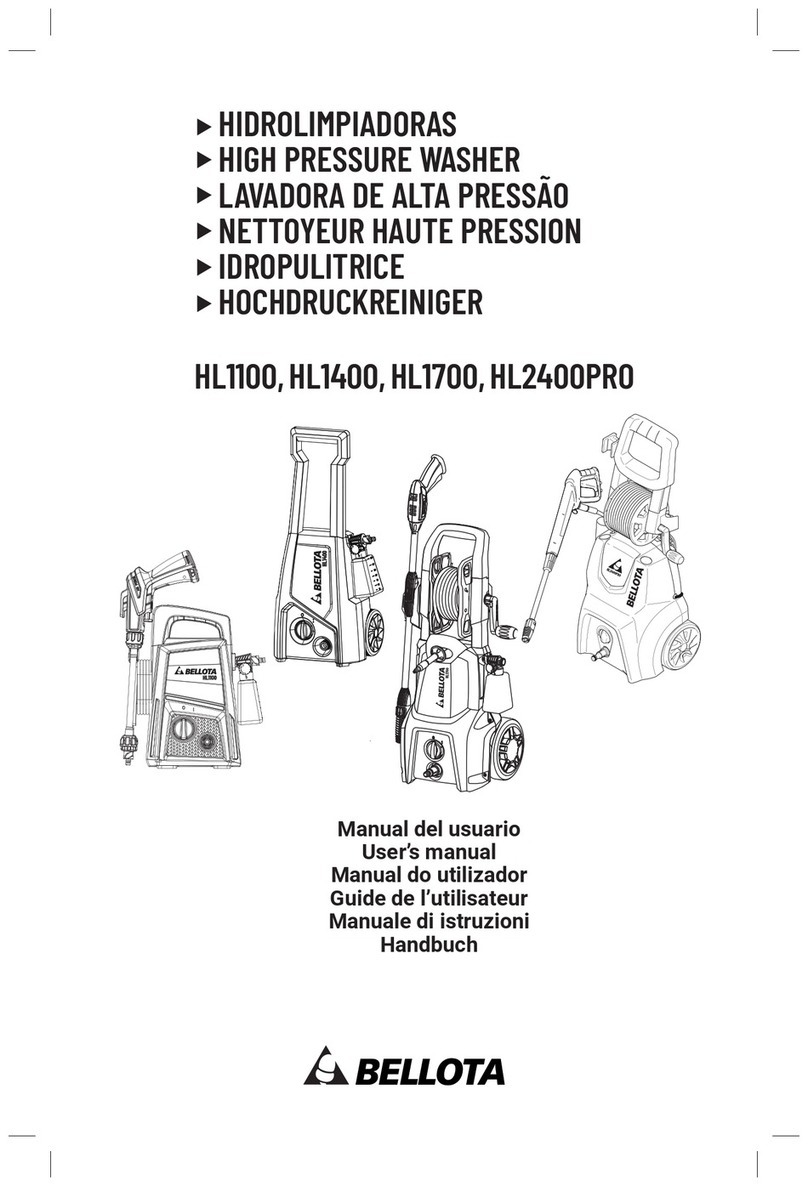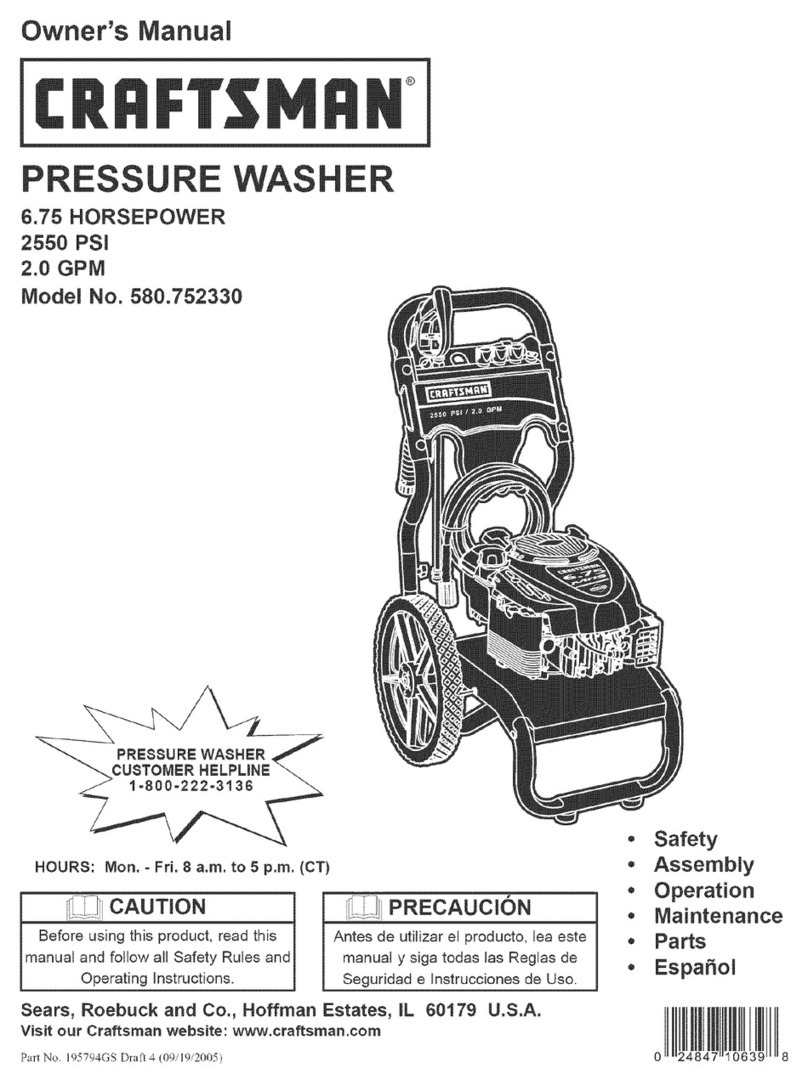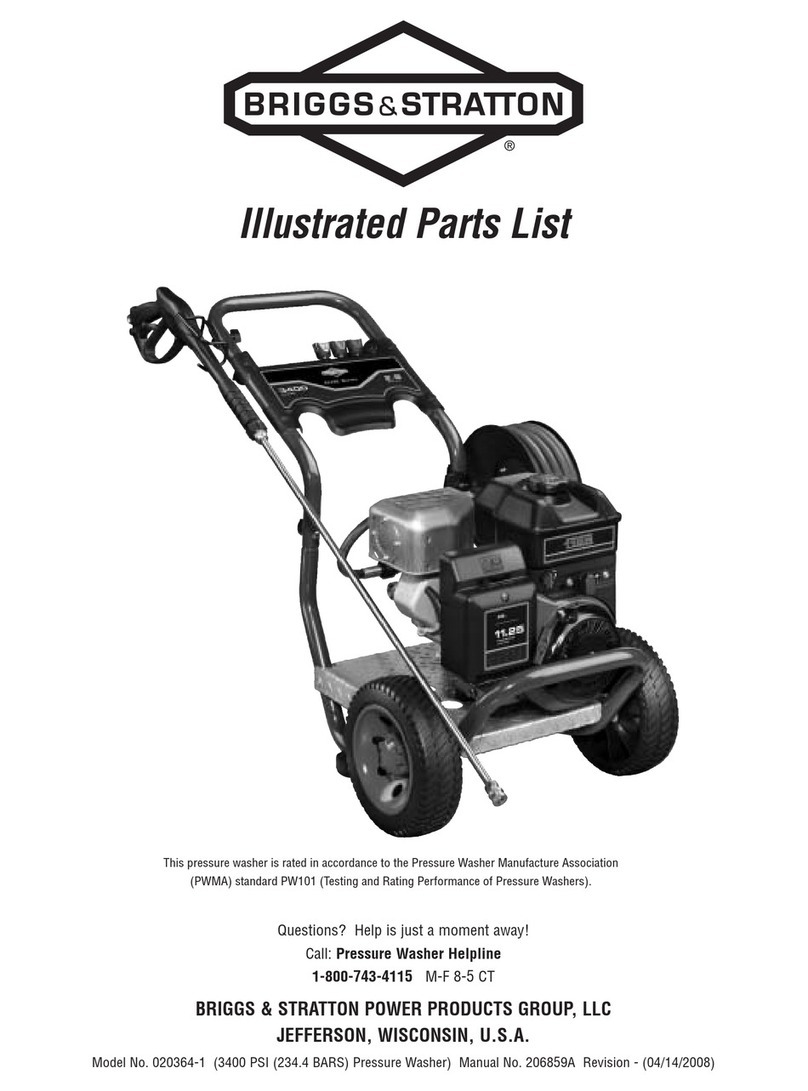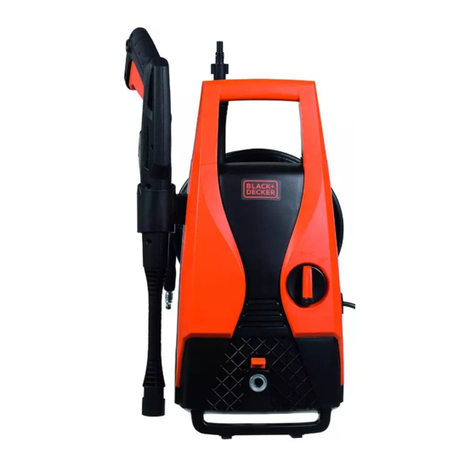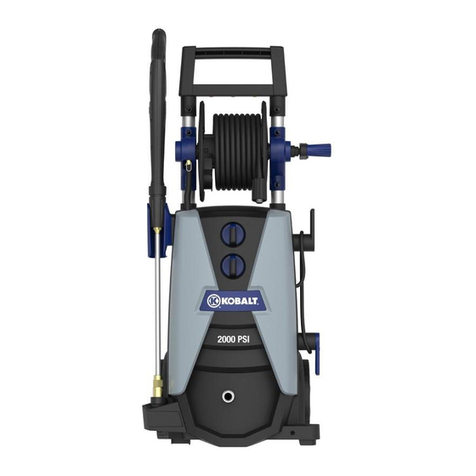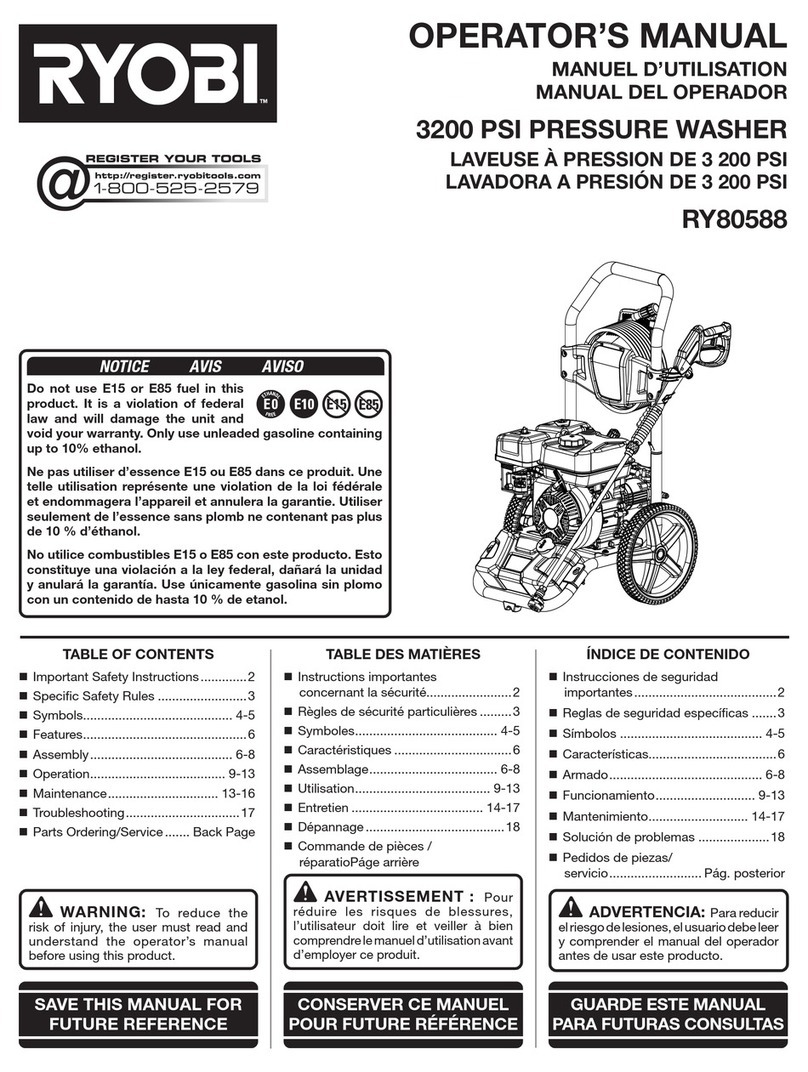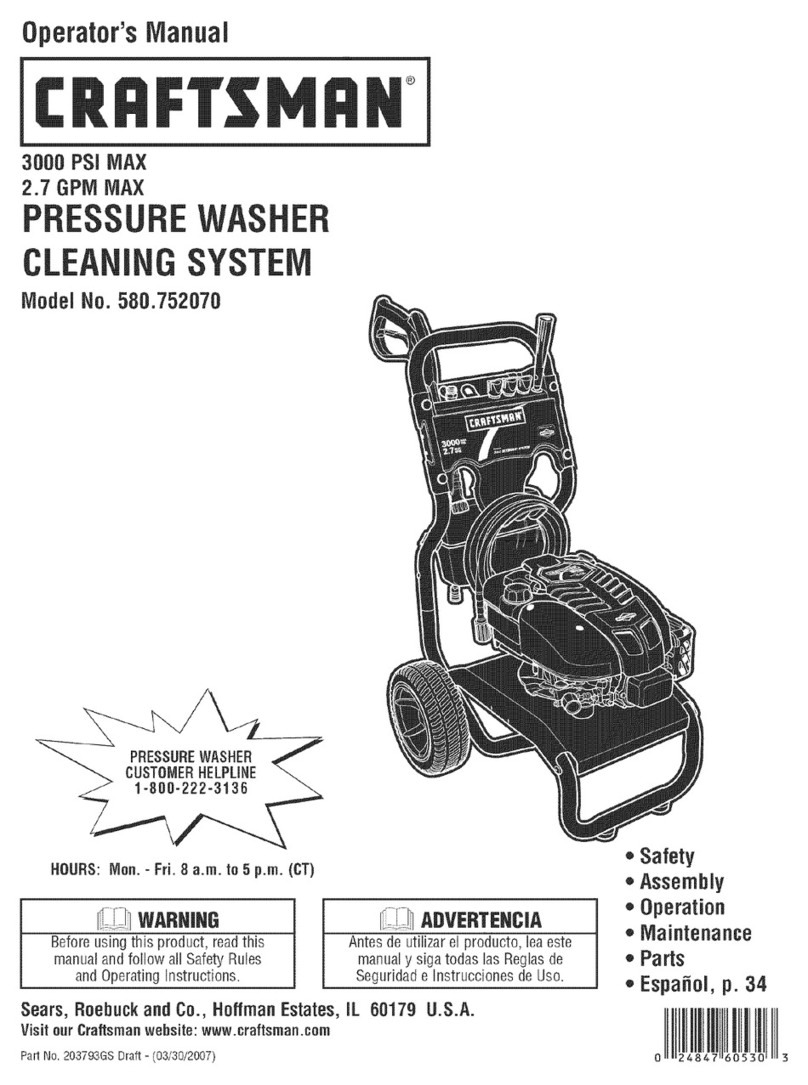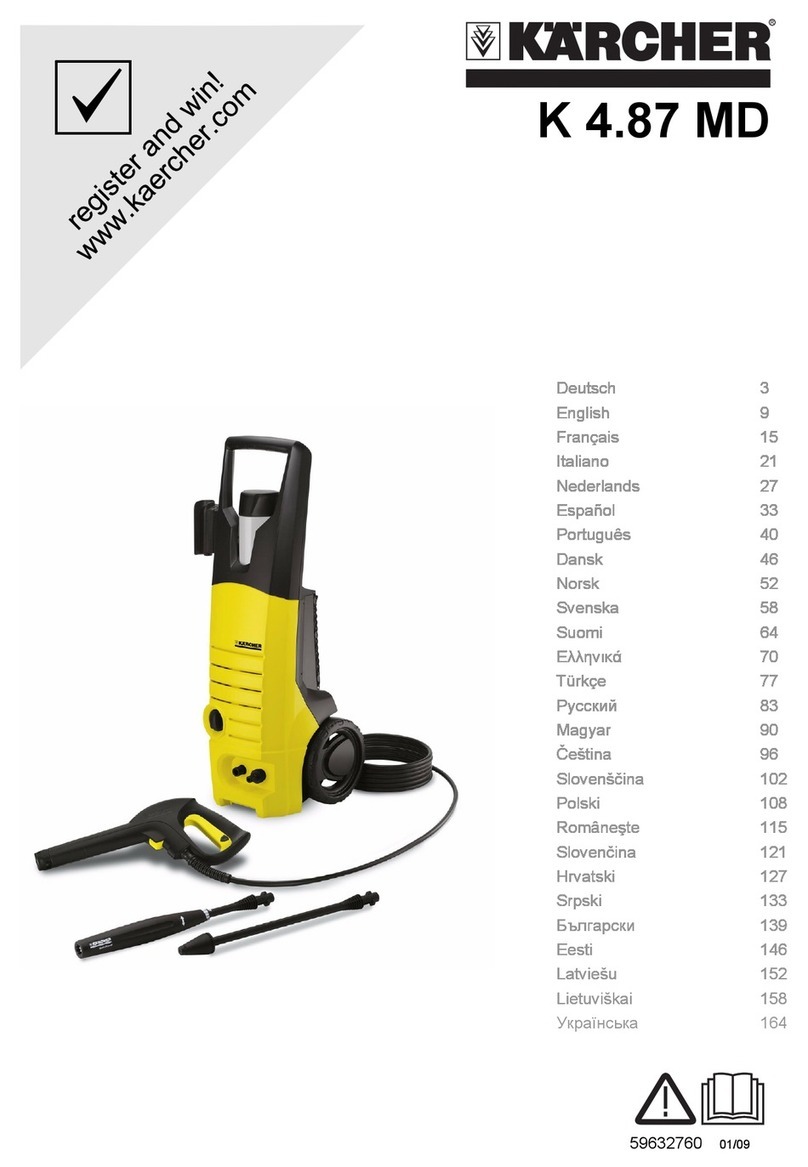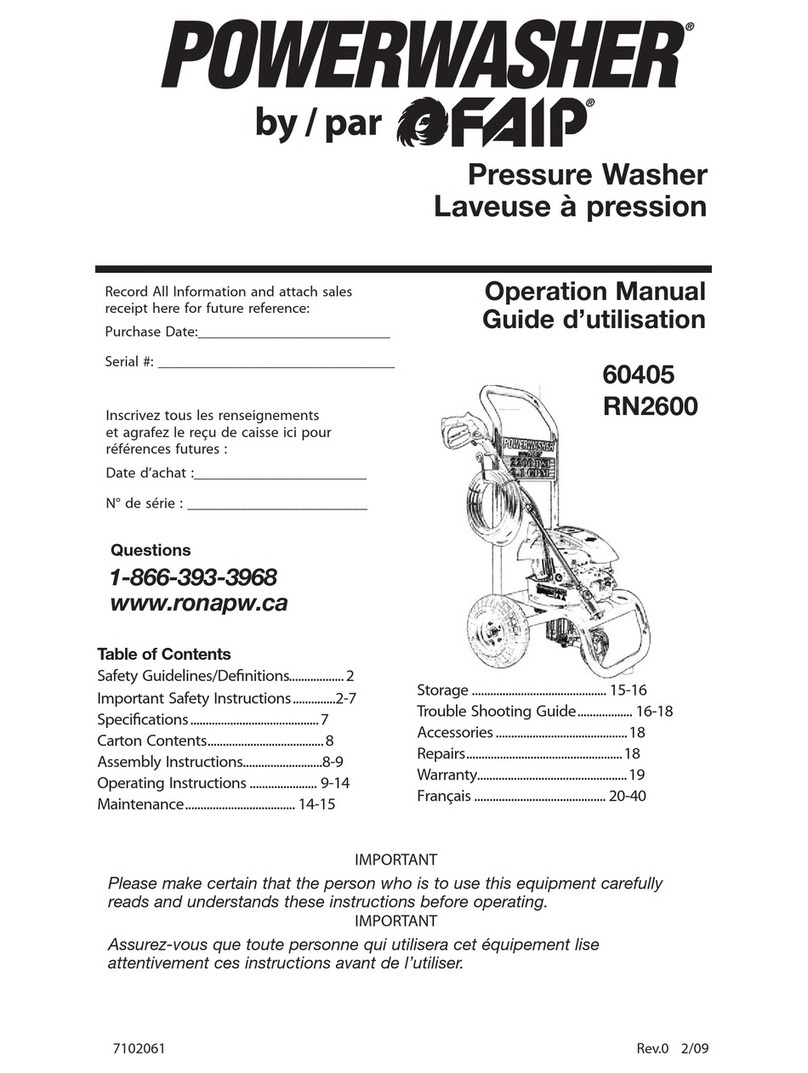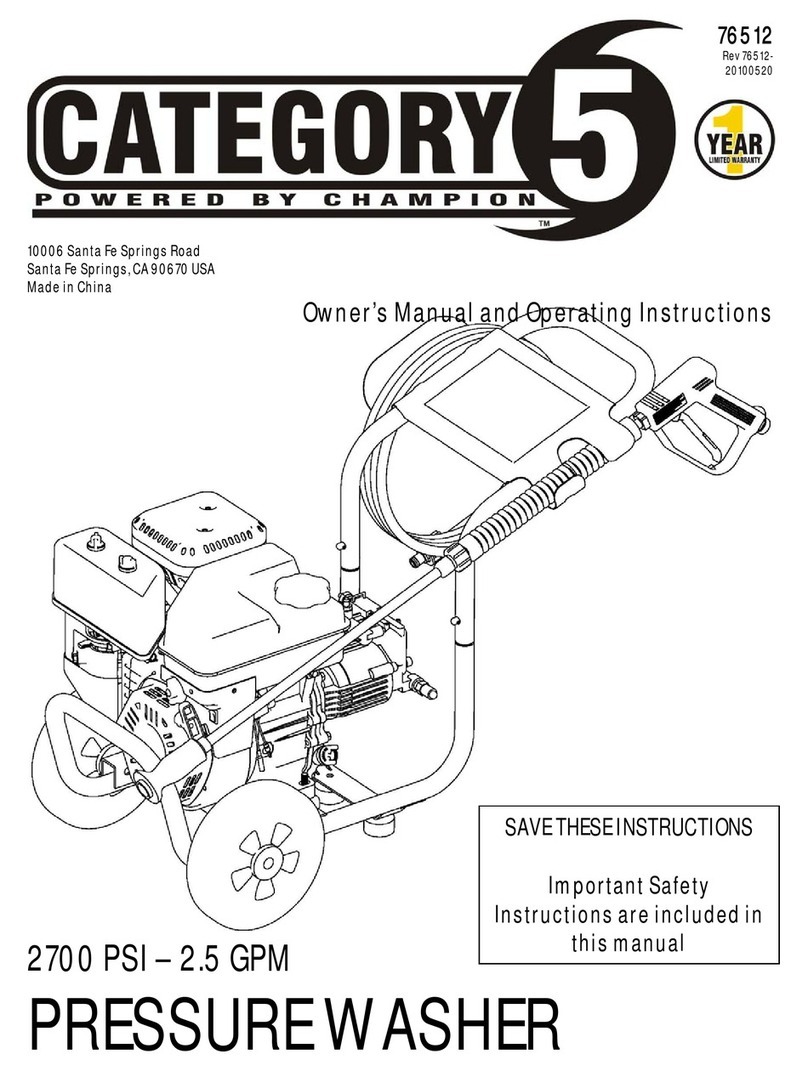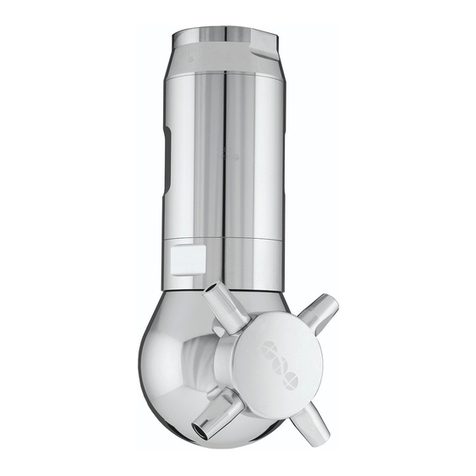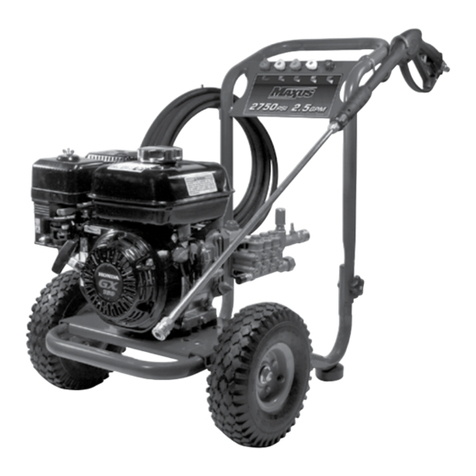Osaki HPW110 User manual

HPW110
ORDER CODE
OSA-279-9620K
OPERATOR’S MA UAL
HIGH PRESSURE WASHER
© The Kennedy Group Ltd. 02/14
QUALITY GUARA TEE & WARRA TY
OSAKI POWER TOOLS carry a one year manufacturer’s warranty.
OSAKI POWER TOOLS are designed & produced
to the highest standards & specifications
OSAKI POWER TOOLS are fully guaranteed against
faulty materials & workmanship
Should they be found to be defective, they will either be repaired or replaced
free of charge (fair wear and tear and/or misuse excepted).
Please retain supplier invoice as proof of purchase.
AVAILABLE FROM YOUR DISTRIBUTOR
•For easy cleaning of
vehicles, patios and other
light duty applications
•Compact and portable
design
•Adjustable lance
nozzle for fan or
open jet wash
pattern
•Hose reel with foldaway
handle
•Quick connect
•Attachable soap
dispenser bottle
•5m length
high pressure
hose and
trigger gun
•5m length
power cord
•Automatic
on/off
•110 bar pressure
•1800W motor
E C ELECTROMAG ETIC COMPATIBILITY DIRECTIVE 2004/108/EC
E C MACHI ERY DIRECTIVE 2006/42/EC
DECLARATIO OF CO FORMITY
We hereby certify that OSAKI HPW110 high pressure washer
complies with all the relevant provisions of the EC Directives:
Electromagnetic Compatibility Directive 2004/108/EC
Standards Applied: EN 55014-1:2006, EN 55014-2:1997+A1:2001+A2:2008,
EN 61000-3-2-:2006, EN 61000-3-3:1995+A1:2001+A2:2005, EN 61000-3-3:2008
achinery Directive 2006/42/EC
Standards Applied: EN 60335-1:2002+A11:2004+A1:2004+A2:2006+A12:2006+A13:2008
EN 60335-2-79:2009, EN 62233:2008.
Official Age t
KENNEDY TOOLS
Wigsto Works, Leicester, E gla d, LE18 2FS.
Supplied by a ISO9001 approved compa y.
Signed:
Date: 3rd February 2014 Name: Keith Read Position: HSQE Group Manager

2
SAFETY I STRUCTIO S
Osaki Power Tools are committed to the Production of Quality Power Tools
that are designed for high performance and long service life.
If safety and maintenance procedures are observed they will last for many years.
Man, Earth and the Universe
are forces that create an
immovable centre of balance . . . the
balance of power
“
”
GE ERAL SAFETY
•
Read the safety instructions before using the pressure washer.
•
To reduce the risk of injury, close supervision is necessary
when the product is used near children. Do not allow the
pressure washer to be used by children or people who are not
familiar with it.
•
The pressure washer is intended to be used at a temperature
above 0 degrees.
•
This pressure washer has been designed for use with the
cleaning agent supplied or recommended by the manufacturer.
The use of other cleaning agents or chemicals may adversely
affect the safety of the machine.
•
Wear appropriate safety clothing.
•
Know how to stop the pressure washer and bleed the pressure
quickly by pressing the trigger (See the ‘Operation’ section on
page 4). Be thoroughly familiar with the controls.
•
Stay alert and watch what you are doing.
•
Do not operate the pressure washer when tired or under the
influence of alcohol or drugs.
•
Keep operating area clear of all people and clutter.
•
Do not over reach or stand on an unstable support. Keep a
good footing and balance at all times.
•
The pressure washer must be grounded. The plug must be
plugged into an appropriate outlet that is properly installed and
grounded in accordance with all local codes and ordinances.
Check with a qualified electrician if you are in doubt as to
whether the outlet is properly grounded.
•
When working outdoors only use suitably approved extension
cables with a minimum conductor cross section of 1.5mm2.
The plug connectors must have earthing contacts and be
waterproof. Always disconnect the extension from the mains
electricity supply, before disconnecting the pressure washer
from the extension cord.
•
Do not start and run the pressure washer in the rain or stormy
conditions. Keep all connections dry and off the ground. Do not
touch the plug or sockets with wet hands. It is very important
not to let water leak into the machine.
•
The pressure washer should be switched off if it is not used for
periods longer than 3 minutes.
•
Maintain a constant water supply when the pressure washer is
running. Without water circulation damage will be caused to
the sealing rings of the machine.
•
It is necessary to turn on the spray lance within one or two
minutes after the pressure washer has been started.
Otherwise, the temperature of the circulating water within the
machine will soon rise to a critical point, which will cause
damage to the sealing rings inside the machine.
•
Do not start and run the pressure washer in a place which is
excessively cold.
•
This pressure washer has been designed for only using
cleaning water. Do not use corrosive chemicals.
•
This pressure washer must be connected to a cold water
source.
•
Hold the spray lance firmly when in use as there is a chance it
might swing back with the force that is inside it.
•
Do not use the pressure washer within the range of persons
unless they are wearing protective clothing.
•
Do not wash any objects which are a health hazard e.g. asbestos.
•
High pressure jets can be dangerous if subject to misuse. The
jet must not be directed at persons, live electrical equipment or
the appliance itself. Pressure washers should not be pointed
less than 30cm away from tyre walls or tyre valves, as it may
be possible to damage them.
•
Do not direct the jet against yourself or others in order to clean
clothes or footwear.
•
Do not spray flammable liquids as this could cause the risk of
an explosion.
•
Disconnect from the electrical power supply before carrying out
user maintenance.
•
To ensure appliance safety, please use only original spare
parts from or recommended by the manufacturer. Do not use
the pressure washer before you have changed them if they are
damaged.
•
Only allow a qualified person to carry out any maintenance or
repairs only using the manufacturer’s approved parts.
•
Store the pressure washer in a dry, secure place, away from
children.
•
If the supply cord is damaged, it must be replaced immediately.
Always check the electrical cables etc and the appliance
before and after every use for any signs of damage/wear and
tear. If any signs of damage have been found discontinue use
immediately and contact a qualified engineer.
•
Never try to move the pressure washer by pulling it with the mains
lead. Do not allow the mains lead to be pulled around corners or
sharp edges. Do not run the pressure washer over the lead.
7
1.Pipe cleaning hose
2. Water hose
3. Water connection coupling
4. Coupling
5. Wash brush
6. Rotating head brush
7. Turbo lance
8. High pressure sandblasting kit
SAFETY INSTRUCTIONS
For your safety, please read the instruction manual before using
accessories.
•When connecting or disconnecting accessories, make sure the
pressure washer is off and discharge hoses are under pressure.
•Always wear appropriate protective clothing such as goggles,
gloves and sturdy shoes or boots.
•In case of exposure to spray mist, wear a respirator.
•Ensure that no person or animal is in the work area.
GENERAL NOTICE FOR USE
•Each method of cleaning can damage the object to be cleaned or
the environment. Therefore test the impact of cleaning prior to use.
We disclaim any responsibility for damages of any kind. Exercise
great caution on soft materials such as joints or fragile parts of
vehicles such as bearings, etc.
TURBO LANCE (7)
•Rapidly rotating pencil jet designed to eliminate tough dirt on large
surfaces.
Note: Use only on very resistant surfaces. Test impact in a suitable
location to exclude material abrasion, crack formation or infiltration
beneath surfaces.
ACCESSORY KIT I STRUCTIO S
BRUSH ATTACH ENT (5 & 6)
To attach brush to spray lance (See fig 9):
•Screw coupling part (A) onto the end of the brush.
•Insert brush into the end of the spray lance, then turn and lock to
ensure a firm connection.
•Installing or removing components of the device should take place
only when the pressure washer is turned off, unplugged and the
pressure has fallen.
COUPLINGS (3 & 4)
Note: When new, it may be necessary to pull vigorously to remove the
adapter.
PIPE CLEANING HOSE (1)
•This is an ideal choice for cleaning pipes and drains with a
diameter of at least 40 mm (1.5 ") and a minimum radius of 70 mm
(2.75 ").
•If the high pressure hose is not fixed, it can move uncontrollably
and its powerful jet of water can injure people.
•Do not activate the high pressure jet nozzle until hose is at least
50cm inside the pipe to be cleaned.
•Once the high pressure jet is activated, never completely remove
the high pressure hose to clean the pipe.
•When cleaning is complete, turn off the pressure washer and
disconnect the pipe cleaner from the high pressure gun.
Note: The hose must be inserted in the gun base unit. You may need
to disconnect the cleaning lance or other accessory from the gun first.
Note: Be aware of the possibility of dirty water splashing backwards
and contaminating the environment.
HIGH PRESSURE SANDBLASTING KIT (8)
Note: The hydroblasting eliminates dirt, rust and paint etc. but the
water and sand particles can also damage the object to be cleaned.
Assembly:
•The nozzle must be inserted on the pistol grip of the basic device.
If applicable, you must first remove the lance previously inserted.
•The suction pipe must be dipped into the container that contains
silica sand or other blasting agent. Protect container with sand
against moisture.
•As soon as the water flows at high pressure through the cleaning
lance, sand is sucked by the suction pipe and mixed with water in
the cleaning lance. Silica sand grain or 0.2 to 2 mm aluminium
silicate can be used as sand blasting.
Fig. 9
(A)
(A)

63
SPECIFICATIO S
odel Number HPW110
Order code OSA-279-9620K
Nominal voltage 220-240V
/
50 Hz
Power consumption 1800W
Working pressure 11 pa (110bar)
Maximum permissible pump pressure 16.5 Pa (165bar)
Working flow rate 6 Litres/min
Maximum water supply pressure 0.4 Pa (4bar)
Motor rotation speed 2700rpm
Maximum water temperature 50°C
Water inlet si e 3/4”
Noise level 90db(A)
Vibration level <2.5m/s2
Water protection IPX5
Hose length 5m
Power cord length 5m
Assembled dimensions 1065H x 330W x 290Dmm
Weight 14.6kg
BOX CO TE TS
SERVICE & REPAIR
ACCESSORIES
Repair work o the Osaki high pressure washer ca o ly be carried out by a trai ed
service e gi eer. A comprehe sive i house repair a d service facility is available
through your local age t.
The following accessories/spares are available through your local Osaki distributor:
Lance/trigger assembly Order Code: OSA-280-1706W (As supplied with model HPW110)
5m hose Order Code: OSA-280-1721W (Suitable for model HPW110 and CPW110)
Nozzle for lance Order Code: OSA-280-1708W (Suitable for model HPW110)
Soap bottle Order Code: OSA-280-1700M (Suitable for model HPW110 and HPW090)
Osaki pressure washer accessory kit Order Code: OSA-280-1705W
Kit contents: 1 x Pipe cleaning hose
1 x 6m water hose
1 x Water connection coupling
1 x Coupling (Female hose fitting)
1 x Wash brush
1 x Rotating head brush
1 x Turbo lance
1 x High pressure sandblasting kit
Box contents:
1 x HPW110 high pressure washer with trigger gun and high pressure hose assembly
1 x Adjustable spray lance
1 x 3/4” universal hosepipe connector
1 x Lance/soap dispenser bottle Adapter
1 x Lance clip/holder
1x Soap dispenser bottle
LO G TERM STORAGE
Frost can destroy an incompletely emptied unit. The pressure washer must be stored in a frost-free environment, ensuring that the hose is coiled
without any kinks in it.
MAI TE A CE
WATER INLET
The Osaki high pressure washer is maintenance-
free. However regular inspection of the water
inlet filter on the side will prevent any blockage
restricting the water supply to the pump
(See fig 7).
CLEANING PIN
1. Switch off and unplug from the main power
supply. Using the included tip cleaner, insert
into the nozzle hole and move back and
forth until debris is dislodged (See fig 8).
2. Remove additional debris by back-flushing water through the nozzle. To do this, place the end of a garden hose (with water running) to the end
of nozzle for 30-60 seconds.
Fig. 8Fig. 7
OSA-280-1705W

45
OPERATI G I STRUCTIO S
THIS ACHINE UST BE CONNECTED TO A COLD WATER SOURCE ONLY.
THE OTOR OF THIS PRESSURE WASHER WILL NOT RUN CONTINUOUSLY. IT WILL ONLY
OPERATE WHEN THE TRIGGER OF THE SPRAY GUN IS SQUEEZED.
IT IS VERY I PORTANT TO BLEED THE PRESSURE WASHER BEFORE USING IT.
Fig. 4
Fig. 2Fig. 1
Fig. 3
Narrow jet Wide jet
TROUBLE SHOOTI G
Whe switched o , the machi e
will ot start worki g.
Fluctuati g pressure.
Water leaki g from the pump.
The motor stops sudde ly.
The pump does ot reach the
ecessary pressure.
Plug is ot well co ected or electric socket is faulty.
The mai voltage is i sufficie t a d is lower tha
mi imum requireme t.
The pump is stuck.
Thermal safety switch has tripped.
Pump sucki g air.
Valves dirty, wor out or stuck. Pump seals wor out.
Seals wor out.
Thermal safety switch has tripped due to overheati g.
Water i let filter is clogged.
Pump sucki g air from co ectio s or hoses.
Suctio /delivery valves are clogged or wor out.
U loaded valve is stuck.
La ce ozzle i correct or wor out.
Check plug, socket a d fuses.
Check that the mai s voltage is adequate.
Refer to after storage i structio s.
Switch off the u it a d let the motor cool for a
few mi utes.
Leave the la ce ope .
Check that hoses a d co ectio s are airtight.
Clea a d replace, or refer to dealer.
Check a d replace, or refer to dealer.
Check that the mai voltage correspo ds to
specificatio s. Switch off the u it a d let it cool for
a few mi utes.
Clea the water i let filter.
Check that all supply co ectio s are tight.
Check that the water feedi g hose is ot leaki g.
Clear or replace valves.
Loose a d retighte regulatio screw. Check a d/
or replace.
FAULT LIKELY CAUSE SOLUTION
ATTACHING THE SOAP
DISPENSER BOTTLE
When using your pressure washer for cleaning,
there are specially formulated detergents that can
be used, depending on what job you are doing.
For example, if you are cleaning your car, use a
detergent with wax for extra shine (Only use a
cleaning agent supplied or recommended by the
manufacturer).
1. Remove the spray lance extension.
2. Insert the thread end of the accessory
adapter into the opening of trigger gun (See Fig.5).
2. Twist in a clockwise motion to screw the adapter and trigger gun together. Then tighten the screw collar at the end of the spray gun in an anti-
clockwise motion to ensure that there is a tight and secure fitting between both (see fig.5).
3. Insert end of soap dispenser bottle with the plastic locking tabs into the opening of the accessory adapter. Push in, turn, and lock so the soap
dispenser bottle and accessory adapter are secure (See fig. 5).
GUN SAFETY LOCK
When you stop the machine, it is necessary to use the safety lock in order to avoid accidental
activation of the pressure washer (See fig. 6).
1. To activate the safety lock (1), press the yellow button on the trigger gun so that it protrudes
out of the other side with the locked padlock symbol on (See Fig.6).
2. To deactivate the safety lock, press the yellow button back in so that it protrudes out of the
other side with the unlocked padlock symbol on.
Fig. 6
Fig. 5
IDE TIFICATIO
(3) O /OFF SWITCH
(2) FOLDAWAY HA DLE
(1) TRIGGER
GU
(4) HOSE/CORD HOOK
(5) WATER SUPPLY
HOSE CO ECTIO
(6) 5M HIGH
PRESSURE HOSE
(9) HIGH PRESSURE
HOSE OUTLET
(7) ADJUSTABLE
SPRAY LA CE
(8) LA CE
CLIP/HOLDER
1. Connect the water supply hose to the 3/4”
Universal connector - press firmly together to
ensure a tight connection (See Fig.1).
2. Connect the trigger gun hose (6) to the high
pressure hose outlet (9) (see identification).
3. Check that both hoses have no kinks in them.
4. Screw the spray lance (7) extension onto the
end of the trigger gun (1), making sure it is tight
to secure the lance in place.
5. Turn on the mains water supply and check for
any leaks.
6. Depress the trigger on the trigger gun (1) to
allow air to be expelled through the pump and
the hose. ock the trigger (see Fig.6).
7. Plug in the pressure washer to the mains power,
switch on the power and turn on dial (3).
(See fig. 2).
8. Unlock the trigger lock (See Fig.6) and press
down on the trigger to operate pressure washer.
ADJUSTABLE SPRAY
Turn off the pressure washer spray and then adjust
the adjustable spray head (6) by turning it clockwise
or anti-clockwise. Water may be sprayed out either
as a narrow or wide jet (See fig. 3 and 4).
Table of contents
Other Osaki Pressure Washer manuals


